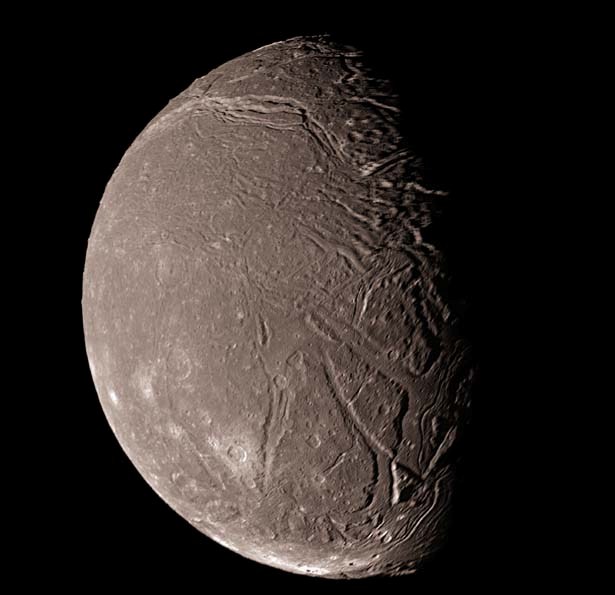|
|
Ariel's Cicatricial Visage
Jan
28, 2009
Every
moon in the Solar System has been
sculpted by violent episodes of
electric discharge machining.
What seest thou else
In the dark backward and abysm of
time?
The Tempest, Act 1 Scene 2
--- William Shakespeare
August 20, 1977, NASA launched the
Voyager 2 spacecraft on a
twelve-year mission to explore the
outer planets. Voyager 2 crossed the
termination shock marking the
edge of the Solar System on July 10,
2008, and will soon be considered an
interstellar spacecraft once it
penetrates the Sun's heliosheath.
During its closest approach to
Uranus in January 1986, Voyager 2
recorded several images of the giant
planet's family of moons and found
them to be scenes of cataclysmic
devastation, with giant craters,
wide and deep valleys, and long,
sinuous cracks, or rilles extending
for hundreds of kilometers. Among
those ravaged bodies is Ariel, whose
surface features resemble those
found on many moons in the Saturnian
system.
Ariel is pockmarked with craters
ranging from five to ten kilometers
across—almost undetectable in the
image above—however, a few craters
measuring 20-30 kilometers across
are visible. The crater dimensions
might seem small, but considering
Ariel's equatorial diameter of 1160
kilometers they are comparatively
large.
Conventional understanding proposes
that Ariel has been the scene of
intense geologic activity in the
past several million (if not
billion) years. The rilles and
offset slip faults are said to have
been caused by slow crustal
movements similar to those which are
theorized to cause earthquakes. This
process requires that Ariel was born
long ago, along with its parent and
siblings, from a primordial nebular
cloud.
The parochial nature of scientific
theories demands that the forces
experienced on Earth are to be used
as models for the formations
observed elsewhere and that eons of
time are necessary for them to
mature. However, since there is no
evidence whatsoever that a moon like
Ariel was once subjected to tectonic
activity—other than the
aforementioned conservative
scientific tendency—the Electric
Universe theory states that the idea
should be turned on its head:
structures we see in space should be
used as models for what is found on
Earth.
Since similar patterns are observed
wherever our instruments are
focused, a reasonable hypothesis
would demonstrate how airless,
frozen bodies hovering near
temperatures close to absolute zero
can compare to hot, wet planets. Of
all the cosmic forces under
consideration in consensus
scientific reports about the
universe, electricity is given
little credence, although it is 39
orders of magnitude more powerful in
its effects than gravity. Heating a
solid, or cracking it, is as nothing
when compared to energizing it with
a multi-trillion joule proton beam.
How does the electric force manifest
itself?
One remarkable example is the
bright-edged crater to the left of
the central scar: it is
hexagonal, much like
craters on nearly every
celestial body in the Solar
System,
Earth included. How can the
detonation of a colliding rock cause
a hexagonal crater? No experiment
has been able to demonstrate a
polygonal shape left behind after an
explosive event.
Explosions (such as that from a
meteor impact) do not aggregate
constituent particles into stable
configurations; they induce chaotic
behavior that leaves little in the
way of identifiable forms. As has
been pointed-out in several previous
Picture of the Day articles,
hexagons are created when intense
particle beams touch down on a solid
surface.
Researchers studying the issue
have found that beams of electricity
flowing through plasma create a
central column surrounded by
concentric cylinders. The
cylindrical current
filaments exhibit long-range
attraction and short-range repulsion
braiding that result in evenly
spaced vortices surrounding the
column. As the filaments rotate
around one another, a preferred
hexagonal cross-section forms within
the innermost column.
The steep-walled scarps crossing
Ariel are reminiscent of those on
Saturn's moons Enceladus, Tethys,
and Dione, or Jupiter's moon Europa,
or Hadley Rille on the Moon. It
could also be said that the great
Rift Valley on Earth shares some
characteristics with the long chasms
that span other worlds.
Enceladus, Mars, Mercury, Ganymede:
these and many others compare to the
morphology of Ariel. Size is not
important; mineralogical composition
is not important; temperature or
distance from the Sun are not
important; what is important are the
electric currents flowing through
space and their interactions with
clouds of plasma. Lightning bolts of
immense size and power can be
generated that are capable of
incinerating any matter, or tearing
it to pieces in electrodynamic
vices. The resulting scars and
craters are the remnants of those
cutting and piercing forces.
By Stephen Smith
|
|
|
|
|
|
SPECIAL NOTE - **New Volumes Available:
We are pleased to announce a new
e-book series
THE UNIVERSE ELECTRIC. Available now, the first volume
of this series, titled Big Bang, summarizes the failure of modern cosmology
and offers a new electrical perspective on the cosmos. At
over 200 pages, and
designed for broadest public appeal, it combines spectacular
full-color graphics with lean and readily understandable
text.
**Then second and third volumes in the series are now available,
respectively titled Sun and Comet, they offer
the reader easy to understand explanations of how and why these bodies
exist within an Electric Universe.
High school and college students--and teachers in
numerous fields--will love these books. So will a large
audience of general readers.
Visitors to the Thunderbolts.info site have often
wondered whether they could fully appreciate the Electric
Universe without further formal education. The answer is
given by these exquisitely designed books. Readers from
virtually all backgrounds and education levels will find them
easy to comprehend, from start to finish.
For the Thunderbolts Project, this series is a milestone.
Please see for yourself by checking out the new
Thunderbolts Project website, our leading edge in
reaching new markets globally.
Please visit our
Forum
|
|
|
|
|
|
|
|







